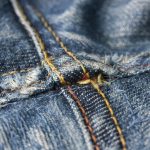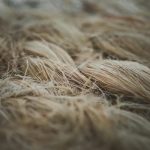You’ll find that jute fabric’s tensile strength comes from its cellulose-rich fibers, which give it rigidity, while hemicellulose and lignin add elasticity and durability. Factors like fiber alignment, moisture, and weaving all play roles in how strong the fabric gets. Standard tests like ASTM D5035 help you measure this reliably. Compared to cotton, jute is stronger, yet blending or treating it can boost strength further. Keep exploring to see how these details impact its practical uses.
Table of Contents
Key Takeaways
- Jute fibers’ tensile strength is mainly due to high cellulose content providing rigidity and load-bearing capacity.
- Proper fiber alignment and tight weaving significantly improve the tensile strength of jute fabric.
- Moisture control and chemical treatments like alkaline or silane enhance or maintain tensile strength.
- Standard tensile testing methods, such as ASTM D5035 and ISO 13934-1, ensure reliable strength measurements.
- Jute has higher tensile strength than cotton but generally lower than hemp or flax fibers.
Composition and Structure of Jute Fibers
Jute fibers consist mainly of cellulose, hemicellulose, and lignin, which together give the fabric its strength and flexibility.
When you look closely, you’ll see cellulose forms the primary structural component, providing rigidity and tensile strength. Hemicellulose acts as a matrix, binding cellulose fibers and contributing to the fiber’s elasticity. Lignin adds stiffness and resistance to microbial attack, enhancing durability.
The fibers themselves are long and tubular, arranged in bundles that create a natural twist. This structure helps distribute stress evenly when the fabric is under tension.
Understanding this composition allows you to appreciate why jute fabric withstands stretching and tearing, making it ideal for various industrial and textile applications where strength and flexibility matter.
Factors Affecting Tensile Strength of Jute Fabric
The composition and structure you’ve just explored play a significant role in how the fabric handles stress, but several other factors also influence its tensile strength. You need to evaluate fiber orientation, moisture content, weaving technique, and chemical treatments, as each impacts durability differently. Understanding these helps you predict performance under various conditions.
| Factor | Impact on Tensile Strength | Evaluation |
|---|---|---|
| Fiber Orientation | Aligned fibers increase strength | Control during manufacturing |
| Moisture Content | Excess moisture weakens fibers | Proper drying essential |
| Weaving Technique | Tight weaves enhance strength | Choose appropriate weave |
| Chemical Treatment | Can improve or degrade strength | Use treatments carefully |
Standard Testing Methods for Tensile Strength
You need to follow established ASTM and ISO standards to accurately test the tensile strength of jute fabric.
Proper sample preparation plays an essential role in ensuring consistent and reliable results.
Let’s explore the key procedures and techniques you should use.
ASTM Testing Procedures
Although many testing methods exist, ASTM procedures provide a reliable standard for measuring tensile strength.
When you test jute fabric using ASTM methods, you follow specific protocols like ASTM D5035 or ASTM D2256. These outline how to prepare samples, set the testing machine, and apply force until the fabric breaks. You’ll measure the maximum force the fabric withstands, giving you an accurate tensile strength value.
The procedures guarantee consistency by specifying sample size, grip type, and testing speed. By sticking to these standards, you can compare results across labs and batches confidently.
Using ASTM testing procedures helps you get precise, repeatable data critical for quality control and research on jute fabrics.
ISO Tensile Standards
Building on the consistency offered by ASTM procedures, ISO standards provide another widely recognized framework for testing tensile strength in jute fabrics.
You’ll find ISO 13934-1 particularly useful, as it outlines the method to determine the maximum force a fabric can endure before breaking. The standard specifies using a universal testing machine with controlled speed and grip conditions, ensuring reproducibility across different labs.
When you follow ISO protocols, you maintain uniform test conditions—such as specimen dimensions and loading rates—helping you get reliable, comparable results. This approach helps you evaluate fabric durability under tension accurately.
Adopting ISO standards complements ASTM methods, giving you an extensive toolkit for evaluating the mechanical performance of jute textiles with precision and consistency.
Sample Preparation Techniques
When preparing jute fabric samples for tensile testing, ensuring consistent size and shape is crucial to obtaining accurate and comparable results. You should cut samples according to standardized dimensions, typically using a template or die cutter to maintain uniformity.
Carefully condition the fabric by storing it in a controlled environment—usually at 20°C and 65% relative humidity—to stabilize moisture content. Mark the gauge length clearly, as this is the portion where tensile force will be applied. Avoid any defects or folds during cutting, as these can skew results.
Finally, handle samples gently to prevent pre-test damage. Following these preparation steps aligned with standards like ASTM D5035 or ISO 13934-1 helps you achieve reliable tensile strength measurements for jute fabric.
Comparative Analysis With Other Natural Fibers
Since you’re exploring the tensile strength of jute fabric, it’s important to compare it with other natural fibers like cotton, hemp, and flax.
Jute typically exhibits higher tensile strength than cotton, making it more durable for applications requiring sturdiness. However, hemp and flax often surpass jute in strength, with hemp known for exceptional tensile properties and flax offering a balanced combination of strength and flexibility.
Jute offers greater tensile strength than cotton, though hemp and flax generally provide superior durability and flexibility.
You’ll find jute’s strength sufficient for many uses, but if maximum tensile performance is critical, hemp or flax might be better choices.
Each fiber’s strength varies based on processing and environmental factors, so consider those when comparing. This comparison helps you understand jute’s position in natural fiber applications, guiding selection based on tensile requirements without delving into enhancement methods.
Enhancing Tensile Properties Through Treatment and Blending
While jute’s tensile strength holds up well against some natural fibers, you might want to enhance its performance for more demanding applications. Treatments like chemical modification and blending with stronger fibers can greatly boost its durability and resistance. You can improve flexibility, reduce moisture absorption, and increase tensile strength by combining these approaches.
| Treatment/Blend | Effect on Tensile Strength |
|---|---|
| Alkaline Treatment | Removes impurities, increases fiber bonding |
| Silane Coupling Agent | Enhances fiber-matrix adhesion |
| Blending with Cotton | Adds softness, moderate strength increase |
| Blending with Polyester | Major strength and durability boost |
| Enzyme Treatment | Improves fiber surface, enhances strength |
These methods let you tailor jute fabric to fit tougher uses without sacrificing its natural appeal.
Applications Influenced by Tensile Strength Characteristics
Because tensile strength directly affects durability and performance, it plays an essential role in determining where and how you can use jute fabric.
Tensile strength is key to jute fabric’s durability and guides its practical applications.
When you select jute fabric, understanding its tensile properties helps you match its strengths to specific applications, ensuring longevity and reliability.
For example, stronger tensile strength means better resistance to tearing and wear, which is vital in certain uses.
Here are some applications influenced by jute’s tensile strength characteristics:
- Packaging materials like sacks and bags that hold heavy loads
- Geotextiles for soil erosion control and reinforcement
- Upholstery and home décor where durability matters
- Agricultural textiles supporting crops and plants
- Eco-friendly fashion accessories requiring strength and flexibility
Frequently Asked Questions
How Does Humidity Affect the Shelf Life of Jute Fabric?
You’ll find that high humidity speeds up jute fabric’s deterioration by promoting mold and weakening fibers. To extend its shelf life, you should store it in a cool, dry place with good ventilation to prevent moisture buildup.
What Environmental Impacts Result From Jute Fiber Production?
Like a double-edged sword, jute fiber production can both heal and harm the environment. You’ll find it reduces carbon footprints but might cause water pollution and soil degradation if not managed carefully.
Are There Any Health Risks Associated With Handling Raw Jute Fibers?
You might experience skin irritation or respiratory issues when handling raw jute fibers due to dust and natural oils. Wearing gloves and masks helps minimize these risks and keeps you safe during processing and handling.
What Are the Economic Benefits of Jute Cultivation Worldwide?
You’ll find jute cultivation boosts local economies by providing jobs, supporting farmers, and exporting raw materials. It’s eco-friendly, reducing plastic use, and creates value-added products, helping you tap into sustainable market opportunities worldwide.
How Is Jute Fabric Recycled or Disposed of Sustainably?
Recycling jute fabric is a breeze—you can compost it since it’s biodegradable or repurpose it into bags and mats. When disposing, avoid landfills; instead, choose eco-friendly methods that let nature take its course without leaving a trace.
- Does Chiffon Fabric Stink - July 15, 2025
- Does Chiffon Fabric Affect the Economy - July 15, 2025
- Does Cotton Fabric Have a Nap - July 15, 2025







